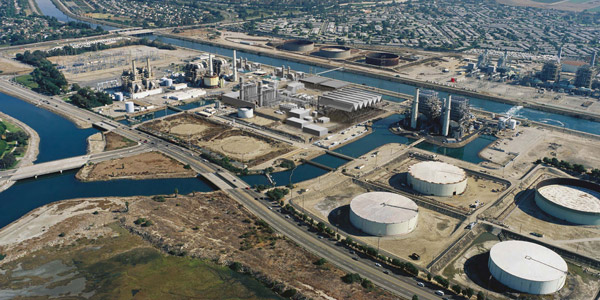Four aging natural gas plants scheduled to retire in December will keep operating because of California’s anticipated capacity shortfall, state water officials decided Tuesday.
The four members of the State Water Resources Control Board voted unanimously to reverse a prior board decision ordering the once-through-cooling (OTC) plants to cease operations by the end of this year, saying they are needed for grid reliability.
“This decision doesn’t come lightly to us as board members,” Chair E. Joaquin Esquivel said. But “there was always the understanding that we needed to balance [environmental concerns with] grid reliability.”
Tuesday’s ruling allows selected units at the Alamitos Generating Station in Long Beach, the Huntington Beach Generating Station in Orange County and the Ormond Beach Generating Station in Oxnard to operate for three more years, until Dec. 31, 2023. The Redondo Beach Generating Station in Los Angeles County got a one-year reprieve to Dec. 31, 2021.
The Alamitos (1,200 MW), Huntington (250 MW) and Redondo (850 MW) plants are owned by AES California. The Ormond plant (1,500 MW) is owned by GenOn.
The OTC plants use ocean water for cooling, killing billions of marine organisms, the water board found. In 2010, it ordered the phase-out of 19 OTC plants along the coast. Some plants retired, while others updated to air-cooling or alternative water-cooling technologies. The last four plants, built in the 1950s and 1960s, still use their original cooling designs.
The hulking plants loom over densely populated coastal communities, wetlands and sandy beaches. Many residents and elected officials want them closed because they are noisy, unsightly and polluting. Dozens spoke at Tuesday’s meeting, encouraging the board to adhere to its original plans.
However, the California Public Utilities Commission projected capacity shortfalls of 2,300 to 4,400 MW starting in the summer of 2021 and extending through 2023. Last year the commission ordered utilities to collectively procure 3,300 MW by August 2023, with 50% to come online by August 2021 and 75% by August 2022. It also recommended the water board extend the OTC compliance deadlines. (See California PUC Votes to Keep Old Gas Plants Operating.)
The three organizations that oversee energy in California — the CPUC, CAISO and the state Energy Commission — urged the water board to let the plants remain open until the new capacity could come online.
“These compliance date extensions would provide a bridge of about 3,740 MW in 2021, 2,230 MW in 2022 and 1,380 MW in 2023,” board staff said in their report.
California is on an ambitious course to supply 100% carbon-neutral energy to retail customers by 2045. It has ample solar generation but still needs thousands of megawatts of battery storage to let solar meet evening demand.
With fossil fuel generation retiring across the West, the OTC peaker plants help the state meet high demand on hot summer evenings after solar generation falls away. The rolling blackouts of Aug. 14-15 occurred under such conditions. (See CAISO Provides More Details on Blackouts.)
The board on Tuesday also voted to amend the retirement dates of the Diablo Canyon Nuclear Power Plant, California’s last nuclear generating station. It extended Diablo Canyon Unit 2’s closing date for eight months to August 2025 and shortened Unit 1’s retirement date by two months to November 2024.
“These revisions match the expiration date of each unit’s Nuclear Regulatory Commission operating license, as requested by the Pacific Gas and Electric Co. as part of its plan to retire Diablo Canyon,” the board said in a written summary.



